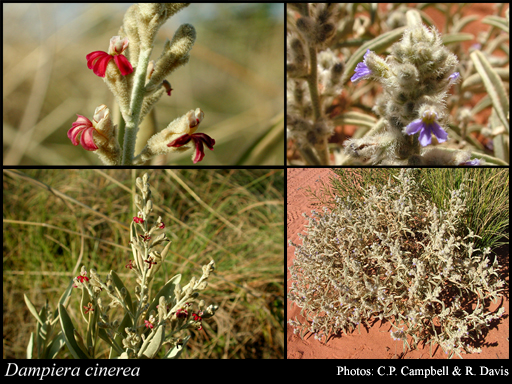- Reference
- Fl.N.Territory 269 (1917)
- Conservation Code
- Not threatened
- Naturalised Status
- Native to Western Australia
- Name Status
- Current
Spreading shrub, 0.2-0.7(-1) m high. Fl. pink-blue-purple/red/white, Mar to May or Jul to Oct. Red sand. Sand dunes.







Scientific Description
Stems unribbed. Leaves flat, 20-60 mm long, 8-20 mm wide, Indumentum present, with dense, dendritic hairs; margins entire or toothed. Bracteoles present, 1-1.4 mm long, hairy, with hairy hairs. Pedicel pedicellate, Pedicel length the pedicels 1-2 mm long, Indumentum present, Hair type with dendritic hairs. Calyx lobes absent. Corolla pink or purple, 4-6 mm long, without auricles, not spurred, hairy on the outside, with dense, dendritic hairs, glabrous on the inside; central lobes 2-2.5 mm long, with wings; outer lobes 3-4.5 mm long, wings present on both sides, 0.3-0.4 mm wide. Anthers connate. Ovary inferior, not gibbose; style 2-3 mm long, glabrous; indusium single, glabrous; ovules one or two. Flowers in March, April, May, June, July, August, September and October. Occurs in the Pilbara (PIL), Great Victoria Desert (GVD), Central Ranges (CR), Gascoyne (GAS), Gibson Desert (GD), Great Sandy Desert (GSD) and Little Sandy Desert(LSD) IBRA Region(s), of the Eremaean (E) Botanical Province.
Distribution
- IBRA Regions
- Central Ranges, Gascoyne, Gibson Desert, Great Sandy Desert, Great Victoria Desert, Little Sandy Desert, Pilbara.
- IBRA Subregions
- Ashburton, Augustus, Carnegie, Central, Chichester, Dune Field, Fortescue, Lateritic Plain, Mackay, Mann-Musgrave Block, McLarty, Rudall, Trainor.
- Local Government Areas (LGAs)
- Broome, Derby-West Kimberley, East Pilbara, Meekatharra, Ngaanyatjarraku, Wiluna.